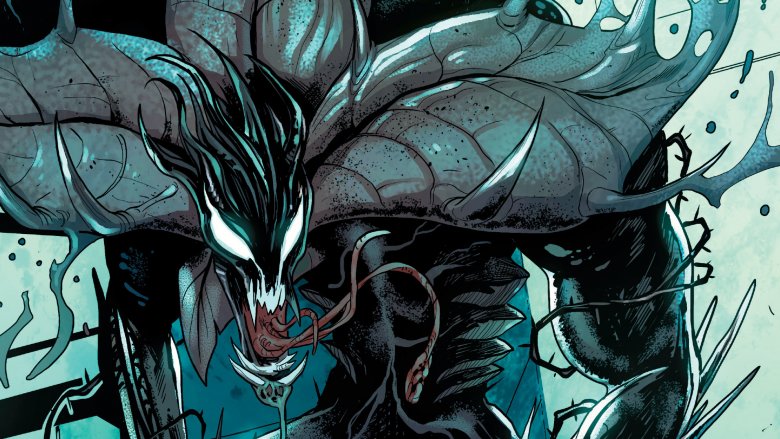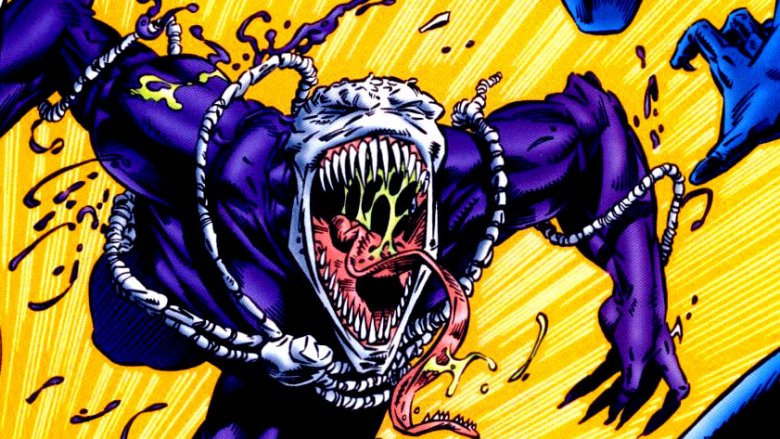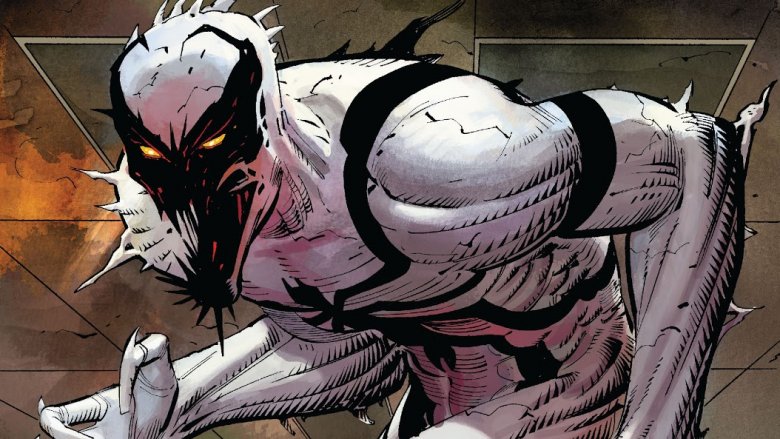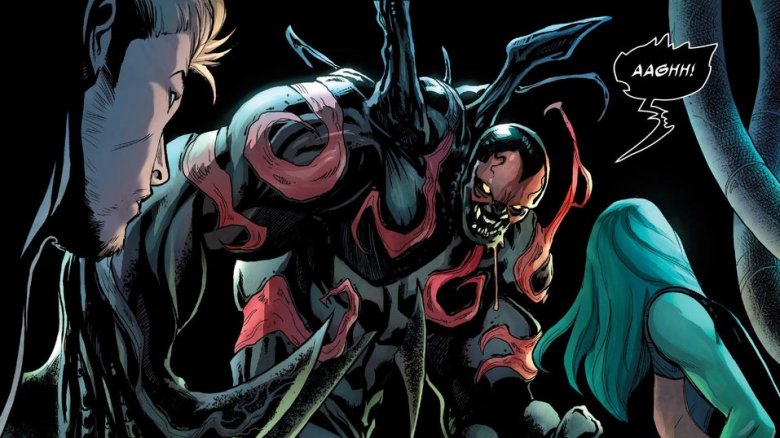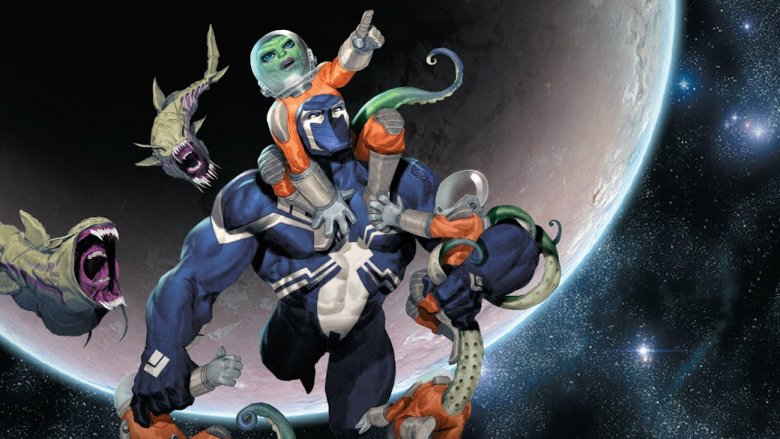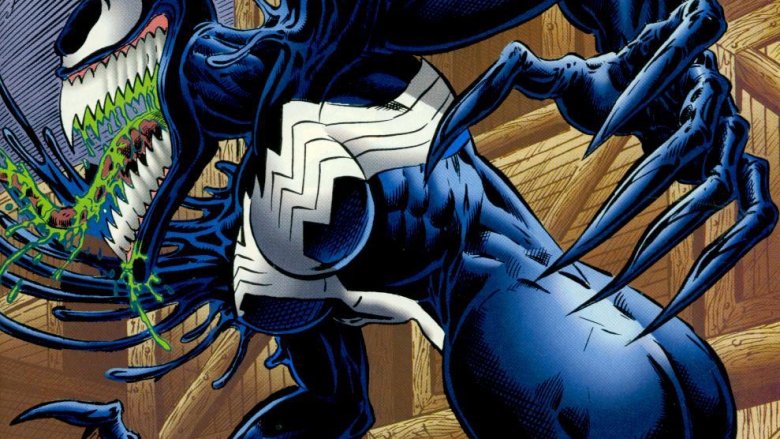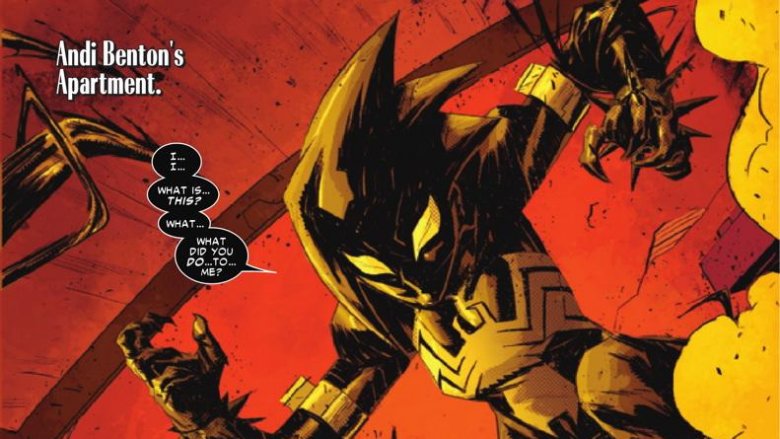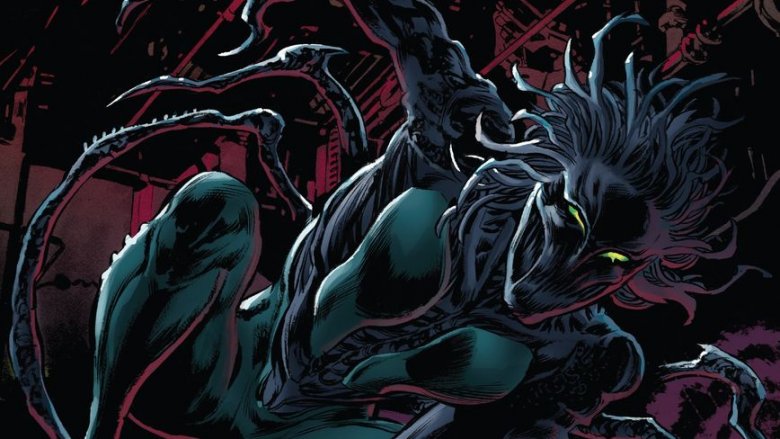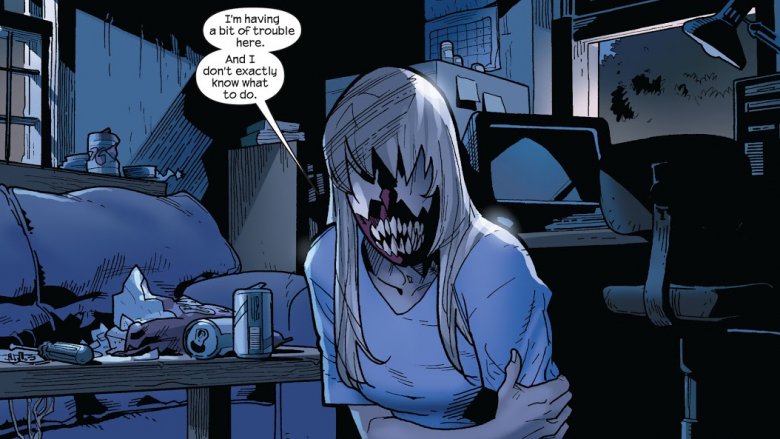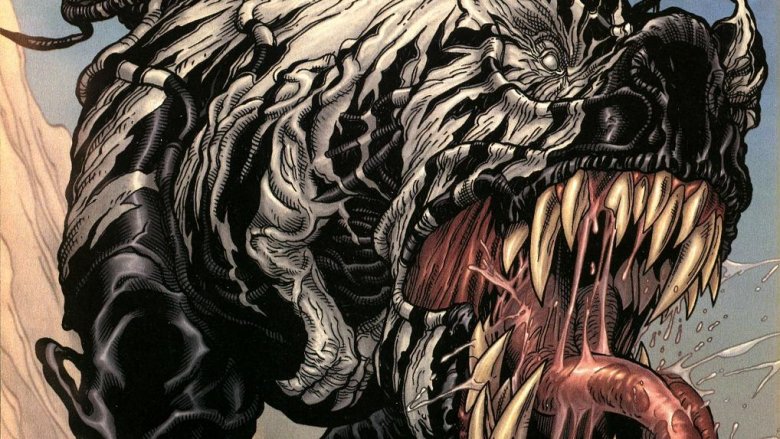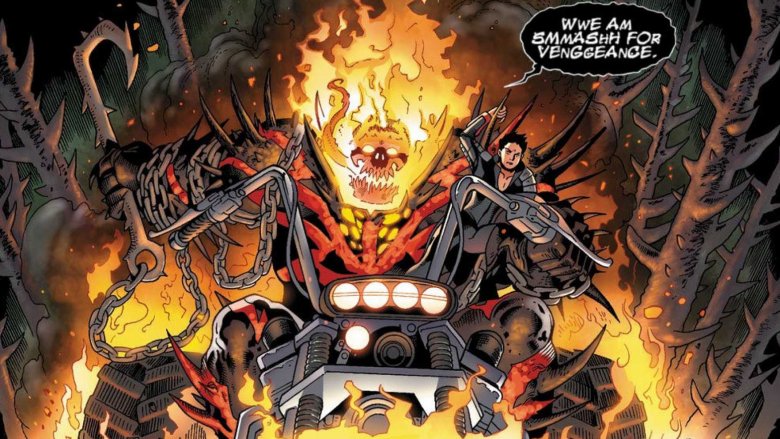The Most Bizarre Symbiotes In The Marvel Universe
The alien symbiote, which eventually became known as Venom, has been a mainstay of Spider-Man's rogues gallery since its introduction in the Secret Wars comic book crossover (Hilariously named such simply because "secrets" and "wars" are two things that kids love the most!). The symbiote was originally just as an alien suit Peter Parker wore after his original Spider-Man costume got destroyed. Spidey got rid of the suit when it started to make him mentally unstable as it bonded with him, and it soon grafted on to fellow Daily Bugle photog Eddie Brock, which is how we got sometime villain, sometime anti-hero Venom! Since then, the symbiote, and many derivations thereof, have grafted onto a wide variety of Marvel universe's finest. Some of these combos have been great, some have been less so, and some have been downright bizarre. Here are our favorite bizarre symbiotes in the Marvel universe.
Venom 2099 (Kron Stone)
One of the main appeals of Venom is how much his origin mirrors Peter Parker's, but Eddie Brock had less success than his more heroic counterpart. Brock felt he was always second-best to Peter; as Venom, he's not even the second-best spider-themed hero in New York and can't manage a consistent win record as a villain either. Stronger, more vicious, and with a backstory that mirrors Spidey's own, Venom is meant to be like a twisted mirror reflection of Peter Parker's worst qualities. In 2099, though, subtext is illegal. Or at least that's the only reason we can think of why Venom 2099 is literally Spider-Man 2099's evil older brother.
In the 2099 imprint, Marvel brought all of its heroes and villains into a cyberpunk future. In Spider-Man 2099, the high concept was that Miguel O'Hara was a scientist in charge of trying to graft Spider-Man powers onto human subjects. As you might've guessed, he eventually got spider powers and became the Spider-Man of 2099, complete with a snazzy new costume, claws, and fangs. Most of the classic Spider-Man villains got reinvented for 2099, usually with more cyborg body parts or technology.
In the case of Venom 2099, he was the combination of the original Venom symbiote — apparently lying dormant in a sewer for decades — and Kron Stone, the aforementioned evil half-brother of Miguel, who had fallen into the sewer after almost being killed by Punisher 2099. While the continuity might have been complex, Venom 2099 certainly wasn't; he was basically the same Venom as the modern-day iteration, except with acid spit and a less interesting costume.
Anti-Venom (Eddie Brock)
Throughout the long history of the Venom symbiote, it's been a metaphor for everything from toxic relationships (venom, get it?) to drug addiction. Unfortunately for the original host Eddie Brock, one storyline saw the symbiote as the only thing keeping him alive from terminal cancer — it turned out that the symbiote had been feasting on the excess adrenaline from the cancer, keeping Eddie from knowing about his illness. A series of events led to Eddie giving up the symbiote and, soon, his cancer was cured by a supervillain with the power to reverse various ailments. When the Venom symbiote showed back up sometimes later, it combined with Eddie's anti-cancer cells to become Anti-Venom.
While he might sound like Aunt May's second cousin, Anti-Venom was a color-reversed version of Venom with the ability to cure drug addiction, symbiote cells, and also cancer. While you might think that a more or less heroic character with the ability to cure cancer would make bigger waves in the Marvel universe, Anti-Venom mostly got into violent misunderstandings with Spider-Man and the Punisher. Anti-Venom's role as the less-than-lethal protector of New York came to an end when Eddie Brock sacrificed the anti-symbiote in order to create a cure for a disease that had turned all of New York into spider-people in one of the most viscerally uncomfortable storylines Marvel has ever published.
The Symbiotes of the Galaxy
For a group of aliens whose work takes them from one end of the universe to the other, the Guardians of the Galaxy are surprisingly susceptible to alien infections. Replacing Tony Stark, Venom/Flash Thompson joined the Guardians as Earth's intergalactic envoy, and the symbiote briefly went wild and attempted to bond with nearly all of the Guardians. First Groot, then Rocket, and finally Drax — all had a brief Venom phase, which is surprisingly similar to having an emo phase in high school. You know, you wear all black without much else happening.
It turned out that the reason the Venom symbiote had gone all Alien (the movie, not the concept) was that the home world it came from had compelled it to return for psychic cleansing. The psychic transmission had gotten a bit mangled in the symbiote's twisted mind just long enough for some cool new designs of Venom-ed Guardians. After that, the Guardians went on their merry way, but not before the Klyntar home planet cured them of any cancers they'd accrued — a strangely common activity for benevolent symbiotes.
Venom: Space Knight (Flash Thompson)
While Eddie Brock is probably the best-known host for the Venom symbiote, another longtime host was Flash Thompson. The one-time bully of Peter Parker became a long-time part of Spider-Man's supporting cast and eventually lost his legs in Iraq. An experimental procedure granted him the use of a captured symbiote, and he became the military-funded Agent Venom. From there, Flash climbed the ranks of the Marvel universe, joining the Secret Avengers and eventually the Guardians of the Galaxy (see previous) where he became Venom: Space Knight. While there's more than a skip and a hop involved in going from secret military missions as a symbiote superhero to a space-faring cosmic protector, a retcon paved the way by revealing that the symbiote was part of a largely benevolent race called the Klyntar.
The Klyntar would bond with hosts in order to provide direction to their formless benevolence, meaning that all of the evil symbiotes in the Marvel universe were actually just aberrations. The Klyntar homeworld restored the mentally unstable Venom symbiote to its pure state, allowing Flash to use it without worrying about being driven insane with the desire to eat people. The "purification process" also gave Flash a brief role as an Agent of the Cosmos, an entire organization made up of heroic symbiotes and their hosts who, for some reason, had never bothered to visit Earth before. As with most storylines involving the original Venom symbiote, the short-lived heroic turn was bungled after the symbiote relapsed into murderous intent.
She-Venom (Anne Weying)
There are a few constants in comic book storytelling: Number one, the female version of a male character will always have visible breasts, even when they are a monster. Number two, being the girlfriend of a popular superhero or supervillain usually ends in your death. Number three, if you're a lawyer in the Marvel universe and your name isn't Matt Murdock or Jennifer Walters, you're going to have a hard time. Unfortunately for Anne Weying, aka She-Venom, she hit all three.
The ex-wife of Eddie Brock, Anne was a lawyer who ended up getting caught in the middle of Spider-Man and Venom's fights over the years. Unfortunately, being a named supporting character in superhero comics rarely ends well for anyone. Nearly killed by another Spidey villain, Anne bonded with a part of the Venom symbiote — multiple times. Eventually, the strain of dealing with an ex-husband that was literally an alien-possessed murderer (combined with her own brief murderous rampages as She-Venom) led to her killing herself. While she wouldn't be the last female Venom in the Marvel universe (or even the last female symbiote in this list), she does win the dubious honor of being one of the worst designed.
Mania (Andrea Benton)
Speaking of female symbiotes, there's also Andrea Benton, aka Mania. Originally a student of Flash Thompson's when he was a gym teacher (and the military hero, Agent Venom), Andrea Benton bonded with the symbiote when Flash protected her with his symbiote during an attack by the supervillain Jack O'Lantern. As is common with newly bonded symbiote hosts, Andrea went on a rampage of revenge against Jack O'Lantern as the symbiote-fueled Mania. While that might not normally land her on a list of most bizarre symbiotes, she later found out that she could control demons when she and Venom were attacked by a villain who opened a dimensional portal to Hell.
It turned out that when Venom had gone to Hell (more on that later), Mephisto had made a deal with the symbiote that made it a possible successor as the Lord of Hell. When Flash protected Andrea from Jack O'Lantern's attack, the symbiote had actually separated the part of itself infected with the Hell-Mark and dumped it on Andrea. After going briefly insane due to the Hell-Mark's influence (what else do symbiotes do?), Andrea lost the symbiote but retained the ability to shoot literal hellfire and control demons.
Raze (Claire Dixon)
Believe it or not, Mania isn't the only demonically powered symbiote in the Marvel universe. There's also Raze, who owes her creation to a combination of Carnage — the first Venom spinoff and combo of symbiote offspring and serial killer host — and a demon-powered book called the Darkhold. Raze was originally an FBI agent named Claire Dixon who was tasked with hunting down Carnage as part of an anti-Carnage unit that included Eddie Brock (de-powered of his Venom symbiote at the time). Unfortunately, she failed on a pretty massive scale, as her explosive trap actually connected Carnage with the Cthulu-esque Darkhold cult instead of killing him. Newly imbued with demonic powers (though different kind of demonic powers than Mania), Carnage was able to attach a piece of himself to Claire, turning her into the brainwashed Raze.
Claire eventually gave up the symbiote, to help banish the elder God Chthon, and sacrificed her life to protect the rest of her team from Carnage's wrath. While she might not have lasted long in the role of Raze, that's probably for the best. After all, Marvel already has a couple of characters named Raze.
Gwen Stacy Carnage
We've mostly stayed with the main Marvel universe (usually designated Earth 616) when talking about bizarre symbiotes, but there's plenty to go around in the larger multiverse. Over in the Ultimate universe (Earth 1610), Gwen Stacy ended up in control of the Carnage symbiote. Oh, and she was also a clone after the original Gwen Stacy was murdered by the original Carnage.
In the beginning, the Ultimate universe was a way to retell some of Spider-Man's classic storylines for a new generation, without the drag of continuity that had led to declining sales and confused fans. In practice, this lasted about a few years before the Ultimate universe ended up with its own complex continuity and bizarre references to little-read events.
The original Gwen Stacy had been consumed by Carnage after Curt Connors (better known as the villain-ish Lizard over in 616) had tried to replicate the Venom symbiote, which was man-made rather than an alien species, like in Earth 616. It turned out that Connors and another scientist had created a clone of Stacy out of the genetic material absorbed by Carnage (in a fun nod to alternate continuity, the other scientist was named Ben Reilly, the name of Spider-Man's own clone in Earth 616). The Carnage Stacy escaped, met up with Spider-Man, and (of course) accidentally kick-started Venom's rejuvenation when she tried to give Eddie Brock a pep talk about not being a monster anymore. Luckily for Gwen 2.0, this freed her of the symbiote's influence, and besides some lingering philosophical questions about whether a clone is really human or not, was able to live a fairly happy life until the literal annihilation of the universe.
T-Rex Venom
Part of the reason that symbiotes end up attached to so many different characters in so many different ways is that there is an undeniable thrill to seeing some of your favorite characters morphed into Venom's trademark sinewy form. Venom-ed characters just look cool, and in a visual medium like comics, looking cool counts for a lot. T-Rex Venom is the logical conclusion of this phenomenon; it just combines two intrinsically awesome things into one even more awesome thing — and it's hard to argue against the T-Rex Venom not being great.
Despite only appearing in a few pages of the Old Man Logan alternate universe (that was originally supposed to be the unavoidable dystopian future of the Marvel universe until a later retcon made it its own universe), T-Rex Venom is the epitome of the book's visuals. If you're showcasing a world in which the ruined detritus of the Marvel universe has led to an America torn apart by supervillains and ridiculous monsters, there's no better symbol of that than a giant tyrannosaurus rex covered in symbiote goo.
Venom Hulk Ghost Rider
Remember when we talked about how Flash Thompson went to Hell and got marked by Mephisto? Well, the storyline also featured Red Hulk, X-23, and Ghost Rider as a team of superheroes with a sneaky similarity to the New Fantastic Four (a short-lived run of the Fantastic Four that featured Wolverine, Spider-Man, Hulk, and Ghost Rider as the eponymous super team). The story involved all four superheroes getting sent to Hell after being murdered by Blackheart, the son of Mephisto (not to be confused with the Son of Satan, a different character), who had brought a chunk of Hell into Las Vegas.
After making a deal with Mephisto to come back to life, Venom gave the symbiote to Red Hulk, already possessed by the Spirit of Vengeance, thus fusing into a Venom Hulk Ghost Rider. The fact that all four heroes had died and literally made a deal with the devil turned out to have repercussions; in Flash's case, it involved a Hell Mark that would eventually lead to the production of another crazed symbiote, Mania (see previous). At any rate, the combination of the strength of a Hulk, the Spirit of Vengeance, and the power of the symbiote, turned out to be enough to turn the tide of battle — and turn Las Vegas back from Hell on Earth into the den of sin that we're more comfortable with.
